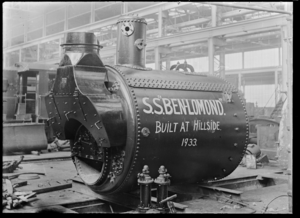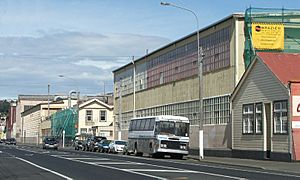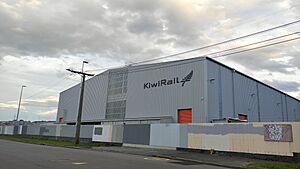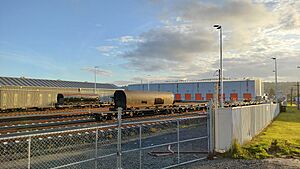Hillside Engineering facts for kids
Hillside Engineering Group is a special part of KiwiRail, which is New Zealand's main train company. Hillside is located in Dunedin, a city in New Zealand. This group mostly works on trains for KiwiRail, but they also do some work for boats and ships in Dunedin.
In 2012, KiwiRail announced they wanted to sell Hillside. Later that year, they sold part of the business to an Australian company called Bradken, and the rest of Hillside was closed down. However, KiwiRail still used the workshops for some train maintenance with a small team.
Then, in October 2019, the New Zealand Government announced exciting news! They decided to invest NZ$20 million to bring Hillside Engineering back to life. The goal was to make it a big center for fixing and building train engines and other train parts for KiwiRail.
Contents
History of Hillside Workshops
Hillside started as the Hillside Workshops for the New Zealand Railways Department in 1901. However, there had been smaller workshops near this spot in South Dunedin since 1875.
The workshops became much bigger in the late 1920s. By 1935, about 800 people worked there, which was a big jump from 365 workers in 1925. At that time, Hillside was the largest railway workshop in the South Island. It covered a huge area, about 16 acres (or 6.5 hectares). By 1945, the number of staff had gone down to 550.
The workshops, located on Hillside Road, were one of the biggest employers in South Dunedin. They were also one of the most noticeable buildings. A part of the nearby Carisbrook sports ground, which was taken down in 2012, was even called "The Hillside End" or "The Workshops End" because the workshops were so close and so large.
Train Car Projects
In 2003, Hillside won a job to fix up several old train cars from Queensland Rail in Australia. These cars were bought from the Zig Zag Railway in Australia. The project took 14 weeks. After they were fixed, the cars were sent to Auckland. There, they were used for daily commuter trains, with a DBR diesel engine at each end.
In 2004, Hillside began rebuilding imported British Rail Mark 2 passenger cars. These cars were also for commuter trains in Auckland. The workers took the cars apart and rebuilt them. They were designed to be used in a "push-pull" setup. This meant a special control car (called SD) was at one end, with several regular cars (called SA) in the middle. A diesel engine (either a DC or DFT) pushed or pulled the train from the other end. Each SD car had a quiet room for a diesel generator, which made electricity for the train. This rebuilding project finished in 2010.
In 2009, KiwiRail announced that Hillside Engineering would build 26 new passenger cars. These cars were for two of the South Island's long-distance passenger trains: the TranzAlpine and the Coastal Pacific. These new cars were called AK. As part of this project, Hillside also changed 6 existing AG vans into 2 open-air viewing cars and 4 luggage cars. In November 2011, the new cars started being used on the Coastal Pacific train.
In 2010, some people in the local community asked for KiwiRail's train cars to be built right there at the Hillside Workshop.
Sale and Closure in 2012
In November 2012, KiwiRail announced that it had sold part of Hillside to an Australian company called Bradken. The rest of the Hillside workshops would close. This meant about 90 people lost their jobs. Some politicians from the Labour Party said the sale was a "political decision." However, KiwiRail said there wasn't enough work to keep the workshop running fully.
Before this, Hillside had lost a contract to build new wagons for KiwiRail. It was found that Hillside's offer was not as good as others, and they couldn't deliver the wagons fast enough. KiwiRail said they planned to give some work to the new owners of Hillside. Other work would be done at KiwiRail's Hutt workshops, which are near Wellington.
Rebuilding Hillside: 2019 to 2024
After the partial closure, Hillside Engineering's workshops were still used for some train engine and wagon maintenance. A small team from KiwiRail worked there, especially for extra work that the Hutt Railway Workshops couldn't handle, and for fixing trains in the South Island.
On October 30, 2019, the government's Regional Development Minister, Shane Jones, announced a big plan. The government would invest NZ$20 million to bring Hillside workshop back as a major center for heavy engineering. This meant it would fix and service KiwiRail's train engines and other rolling stock (train cars). This investment included updating the two main workshop buildings and fixing the machinery.
On May 20, 2021, another government minister, David Clark, confirmed that Hillside Engineering would get NZ$85 million more. This money was for new facilities to put together about 1,500 wagons. This was part of the government's budget for 2021. Transport Minister Michael Wood also said that about 445 jobs would be created between Hillside and a new train maintenance center in Christchurch. The money for Hillside would also create 150 construction jobs and 45 permanent KiwiRail jobs, including apprenticeships for young people learning a trade.
To celebrate the money for Hillside and the 2021 budget, Prime Minister Jacinda Ardern, Deputy Prime Minister Grant Robertson, and local Dunedin politicians David Clark and Ingrid Leary visited the factory on May 25, 2021. Some opposition parties, like the ACT Party and the New Zealand Taxpayers' Union, said the Hillside investment was a waste of money. However, the national secretary of the Railways and Maritime Union, Wayne Butson, said that fixing up Hillside would be good for both the Otago region and all of New Zealand.
In early 2022, the ACT Party found documents that showed KiwiRail officials were worried about the NZ$85 million the government gave to reopen Hillside. KiwiRail had estimated it would cost between NZ$305 and NZ$400 million to properly equip the factory. KiwiRail had asked for much more money for rail projects, but the government had reduced these requests. KiwiRail also thought they would have to import 780 wagons while Hillside was being rebuilt. The ACT Party's transport spokesperson, Simon Court, said the Hillside project was not well-planned and was based on politics. But Transport Minister Wood and State Owned Enterprises Minister Clark said that the Hillside factory would bring good, high-paying engineering jobs back to Dunedin after the previous government had closed it down.
In mid-August 2022, a news report said that KiwiRail had changed the design of Hillside Workshops because costs were going up. By 2022, the New Zealand Government had given NZ$105 million to the Hillside workshop redevelopment. This included NZ$20 million from a special fund for regional growth and NZ$85 million from the 2021 budget.
By early September 2023, two new tracks were put in at the back of the facility. These tracks are used to move train engines, wagons, and carriages around the workshop. They were finished by the end of 2023.
By February 2024, KiwiRail's regional manager, Alan Hill, confirmed that a lot of progress had been made in fixing up the workshops. The work was expected to be finished by mid-2024. About 90% of the old building materials that were taken down were recycled. The rebuilding was paid for with nearly NZ$20 million from the government's Provincial Growth Fund in 2019, NZ$85 million from the 2021 budget for upgrades and wagon assembly, and NZ$23 million more from the government to replace old train engines and wagons. These investments helped create a new 5,500 square meter workshop with 21 work areas, cranes, and a new train yard layout with electric shunting engines (small engines that move cars around the yard).
Reopening and Present Day
Putting together new wagons started in March 2024. By April 2025, 401 wagons had been assembled. In mid-August 2024, KiwiRail made an agreement with two trusts to turn the old Manager's House on Hillside Road into a place that celebrates the history of the workshops.
Hillside Engineering officially reopened on May 16, 2025, with a special ceremony. Important people like Deputy Prime Minister Winston Peters, Regional Development Minister Shane Jones, and KiwiRail CEO Peter Reidy attended. During the ceremony, Peters said that Hillside Engineering coming back showed the government's "belief in the city of Dunedin." Some people also gathered outside the ceremony to protest about various issues.
Locomotives Built at Hillside
Hillside built many different types of train engines over the years:
- DSC
- C (1930) (12 engines)
- JA (35 engines)
- KB (6 engines)
- L
- WA (6 engines)
- WAB (20 engines)
- WF (16 engines)
- WG (20 engines)
- WW (48 engines)
- TR (9 engines) (These were diesel shunting engines built from 1973–1978)
Hillside also rebuilt these types of train engines:
- DG (10 engines)
- G (1928) (6 engines)
- WE (3 engines)
- X (1 engine)
See also
- New Zealand British Rail Mark 2 carriage, which were rebuilt at Hillside Workshops and Hutt Workshops
- NZR Addington Workshops, in Christchurch
- NZR Hutt Workshops, near Wellington
- NZR Newmarket Workshops in Auckland, and later Otahuhu Workshops, also in Auckland
- New Zealand Railways Department





